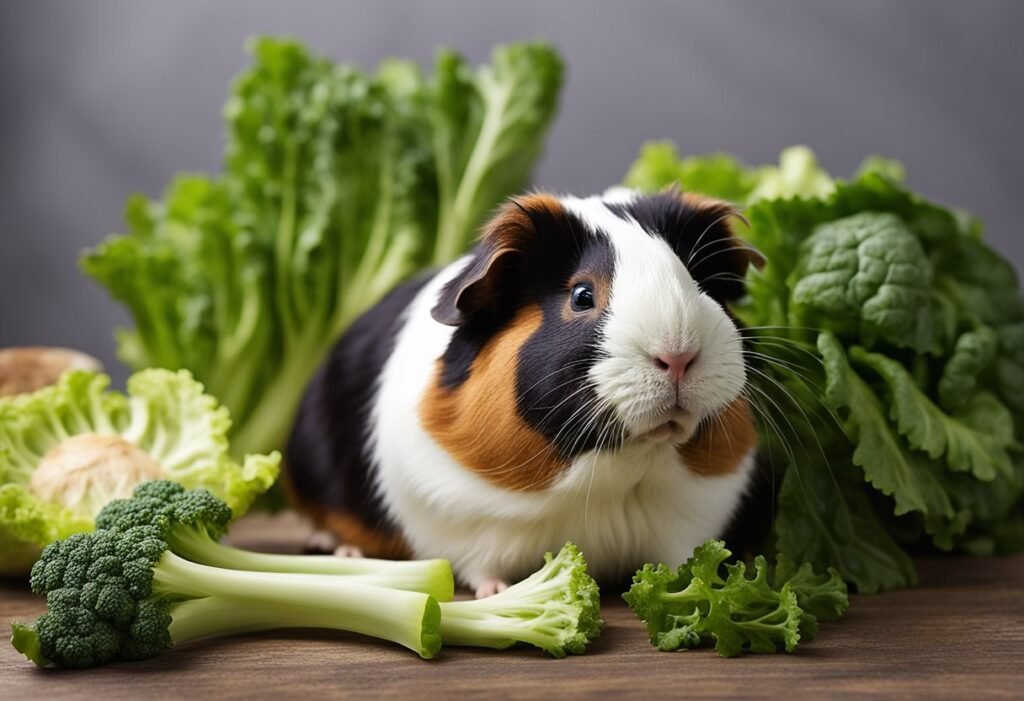Guinea pigs are adorable and friendly pets that require a balanced diet to maintain their health. As a responsible pet owner, it’s essential to provide your guinea pig with a variety of fresh fruits and vegetables. Escarole is a leafy green vegetable that is often used in salads and other dishes. If you’re wondering whether guinea pigs can eat escarole, we have the answer for you.
In short, guinea pigs can eat escarole. In fact, it’s a great source of vitamin C, which is an essential nutrient for guinea pigs. However, like with any new food, it’s important to introduce it slowly and in small quantities to avoid digestive problems. In this article, we’ll discuss the nutritional benefits of escarole for guinea pigs, how to prepare it, and some important things to keep in mind when feeding it to your furry friend.
Nutritional Benefits of Escarole for Guinea Pigs

Escarole is a type of leafy green vegetable that is safe for guinea pigs to eat. It is a great source of essential vitamins and minerals that are important for their overall health and well-being. Here are some of the nutritional benefits of escarole for guinea pigs:
High in Vitamin C
Escarole is an excellent source of vitamin C, which is essential for guinea pigs since they cannot produce this vitamin on their own. Vitamin C helps to boost their immune system, promote healthy skin and coat, and prevent scurvy. One cup of escarole contains approximately 14% of the daily recommended intake of vitamin C for guinea pigs.
Rich in Fiber
Escarole is also high in fiber, which is important for maintaining healthy digestion in guinea pigs. It helps to prevent digestive problems such as bloating, constipation, and diarrhea. Fiber also helps to keep them feeling full and satisfied, which can prevent overeating and obesity.
Low in Calcium
While calcium is an important mineral for guinea pigs, too much of it can lead to health problems such as bladder stones and urinary tract infections. Escarole is a low-calcium vegetable, making it a great addition to their diet without the risk of overloading them with this mineral.
Other Nutrients
In addition to vitamin C and fiber, escarole also contains other essential vitamins and minerals such as vitamin A, vitamin K, folate, and potassium. These nutrients can help to support their overall health and well-being.
Overall, escarole is a nutritious and safe vegetable that guinea pigs can enjoy as part of a balanced diet. Remember to introduce new foods slowly and in small amounts to prevent digestive upset.
Risks of Feeding Escarole to Guinea Pigs

While escarole is a nutritious leafy green vegetable that can be safely consumed by humans, it is important to note that it may not be suitable for guinea pigs. Here are some of the risks associated with feeding escarole to guinea pigs:
1. Digestive Issues
Escarole is a high-fiber vegetable that can cause digestive problems in guinea pigs if consumed in large quantities. Excessive consumption of escarole can cause bloating, gas, and diarrhea in guinea pigs, leading to discomfort and potential health issues.
2. High Calcium Content
Escarole is also high in calcium, which can be problematic for guinea pigs. Guinea pigs require a balanced diet with a specific calcium to phosphorus ratio, and an excessive amount of calcium can lead to bladder stones and urinary tract problems.
3. Pesticide Residues
Escarole, like other leafy greens, may contain pesticide residues that can be harmful to guinea pigs. It is important to thoroughly wash and inspect the escarole before feeding it to your guinea pig to minimize the risk of pesticide exposure.
Overall, while escarole can be a healthy addition to a human diet, it may not be the best option for guinea pigs. It is important to consult with a veterinarian or a qualified animal nutritionist to determine the best diet for your guinea pig and ensure their optimal health and well-being.
Proper Serving Size for Guinea Pigs

When it comes to feeding your guinea pig, it’s important to make sure they are receiving the proper serving size of escarole. Overfeeding your guinea pig can lead to obesity and other health issues, while underfeeding can result in malnutrition and weight loss.
As a general rule, guinea pigs should consume about one cup of vegetables per day for every two pounds of body weight. This means that a guinea pig weighing two pounds should consume one cup of vegetables per day, while a guinea pig weighing four pounds should consume two cups of vegetables per day.
When it comes to serving size for escarole, it’s important to remember that this leafy green is high in calcium and oxalates. While calcium is important for guinea pig health, too much can lead to bladder stones and other health problems. Oxalates, on the other hand, can interfere with calcium absorption and should be limited in your guinea pig’s diet.
We recommend serving escarole to your guinea pig in small amounts, about one to two leaves per day. You can also mix escarole with other leafy greens, such as romaine lettuce or kale, to provide a variety of nutrients and flavors for your guinea pig.
Remember to always monitor your guinea pig’s weight and health, and consult with a veterinarian if you have any concerns about their diet or nutrition.
How to Introduce Escarole to Your Guinea Pig’s Diet
When introducing escarole to your guinea pig’s diet, it’s important to start slowly to avoid any digestive issues. We recommend starting with a small amount, such as a few leaves, and gradually increasing the amount over a few days.
It’s also important to wash the escarole thoroughly before feeding it to your guinea pig. This will help remove any dirt or pesticides that may be present on the leaves.
One way to introduce escarole is to mix it with your guinea pig’s regular food. This will help them get used to the taste and texture of the new food. You can also try offering it as a treat, either on its own or mixed with other vegetables.
Remember that escarole should be given in moderation, as too much can lead to diarrhea. We recommend feeding it to your guinea pig once or twice a week, along with a variety of other vegetables.
Overall, escarole can be a healthy addition to your guinea pig’s diet, but it’s important to introduce it slowly and in moderation to avoid any digestive issues.
Frequency of Feeding Escarole to Guinea Pigs
When it comes to feeding escarole to guinea pigs, it is important to keep in mind that it should be given in moderation. While it is a healthy and nutritious vegetable, it should not be the only vegetable in their diet.
We recommend offering escarole to your guinea pigs 1-2 times a week, alongside other vegetables such as bell peppers, carrots, and cucumbers. It is important to provide them with a variety of vegetables to ensure they receive all the necessary vitamins and minerals.
It is also important to note that guinea pigs have sensitive digestive systems, so introducing new vegetables should be done gradually. Start by offering a small amount of escarole and monitor their reaction. If they tolerate it well, you can gradually increase the amount over time.
Overall, feeding escarole to your guinea pigs in moderation can be a healthy addition to their diet. Just remember to offer a variety of vegetables and introduce new ones gradually to avoid digestive issues.
Alternatives to Escarole for Guinea Pigs

While escarole is a great source of nutrition for guinea pigs, it’s always good to mix up their diet with different vegetables. Here are some alternatives to escarole that are safe for guinea pigs to eat:
Romaine lettuce
Romaine lettuce is a great alternative to escarole because it has a similar texture and taste. It’s also high in Vitamin C and other important nutrients that guinea pigs need. Just make sure to avoid iceberg lettuce, as it has little nutritional value and can cause diarrhea.
Bell peppers
Bell peppers are a great source of Vitamin C and other important nutrients for guinea pigs. They come in a variety of colors and have a sweet taste that guinea pigs love. Just make sure to remove the seeds and stem before feeding them to your guinea pig.
Cilantro
Cilantro is a flavorful herb that guinea pigs enjoy. It’s rich in Vitamin C and other important nutrients. Just make sure to feed it in moderation, as too much can cause digestive issues.
Carrots
Carrots are a great source of nutrition for guinea pigs. They’re high in Vitamin A and other important nutrients. Just make sure to feed them in moderation, as they’re also high in sugar.
Spinach
Spinach is another great alternative to escarole. It’s high in Vitamin C and other important nutrients. Just make sure to feed it in moderation, as too much can cause kidney stones.
In conclusion, there are many safe and nutritious alternatives to escarole that guinea pigs can enjoy. By mixing up their diet with different vegetables, you can ensure that your guinea pig is getting all the nutrients they need to stay healthy and happy.
Frequently Asked Questions
What types of leafy greens are safe for guinea pigs to consume?
Guinea pigs need a variety of fresh vegetables and fruits in their diet, including leafy greens. Some safe options include romaine lettuce, kale, spinach, and escarole. It is important to introduce new foods gradually and in small amounts to avoid upsetting your guinea pig’s digestive system.
Are there any toxic leaves that guinea pigs should avoid?
Yes, some plants and leaves are toxic to guinea pigs. Avoid feeding your guinea pig any plants from the nightshade family, such as tomatoes and potatoes. Other toxic plants include rhubarb, avocado, and chocolate. Always research a new food before feeding it to your guinea pig.
Can guinea pigs eat a variety of cabbages including white and red?
Yes, guinea pigs can eat a variety of cabbages, including white and red. However, it is important to feed these vegetables in moderation as they can cause gas and bloating. Always introduce new foods gradually to avoid digestive upset.
Is it safe for guinea pigs to eat mustard greens and similar vegetables?
Yes, mustard greens and other similar vegetables can be safely fed to guinea pigs in moderation. These vegetables are high in vitamin C, which is essential for guinea pig health. However, they should not be fed in excess as they can cause digestive upset.
What are the health benefits of feeding escarole to guinea pigs?
Escarole is a nutritious leafy green that is high in fiber and vitamin C. It also contains vitamin A, which is important for guinea pig eye health. Feeding escarole to your guinea pig in moderation can help support their overall health and wellbeing.
How often can guinea pigs be fed cruciferous vegetables like broccoli and Brussel sprouts?
Cruciferous vegetables like broccoli and Brussel sprouts are high in vitamin C and other nutrients, but they can also cause gas and bloating in guinea pigs. It is best to feed these vegetables in moderation, no more than once or twice a week. Always introduce new foods gradually and in small amounts.





